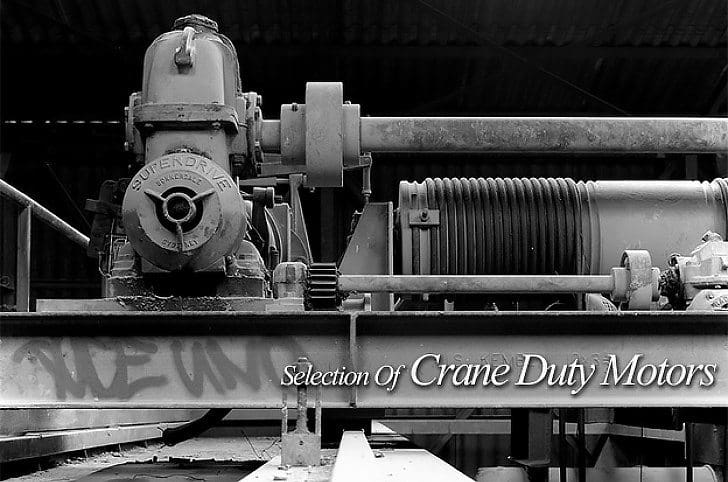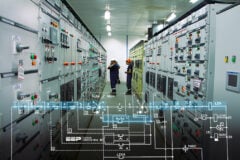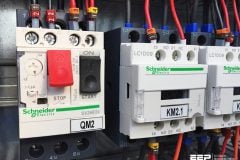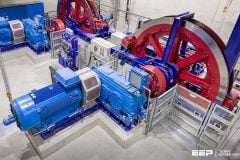Introduction
The operating conditions such as duty cycle, startup, temperature and operating environment are vital considerations in the motor efficiency and reliability. It is absolutely essential to match the motors to their specified operating conditions for minimizing stresses on the motors and to get predetermined performance and life.
One of the areas, in which significant technical requirements are considered lightly or even neglected, is selection of motors for operating various types of cranes and hoists.

These motors are specifically termed as “Crane Duty Motors” and are supplied by all the manufacturers.
Effort is made in this article to discuss in brief the vital factors required to be considered invariably when selecting the motor for performing the crane duty.
Definitions Of Technical Terms
Some technical terms used frequently in intermittent duty drives and hoisting are defined as follows:
1. Duty
Operation of the motor at the declared load(s) including starting, electric braking, no load and rest and de-energised periods to which the motor is subjected, including their durations and sequence in time.
2. Cyclic duration factor
The ratio of the period of energisation/loading, including starting and electric braking, to the duration of the one complete duty cycle expressed as percentage.
![]()
Generally the values for the CDF used are 25%, 40%, 60% and 100%.
3. Starting
The process of energizing a motor to bring it up to rated speed from rest.
4. Jogging or inching
This is an incomplete start during which the motor does not attain more than 25% of the rated speed.
5. Electric braking
A system in which a braking action is applied to an electric motor by causing it to act as a generator.
6. DC Injection braking
A form of braking of an induction motor in which a separate dc supply is used to magnetize the motor.
7. Plug braking
A form of electric braking of an induction motor obtained by reversing the phase sequence of its any two lines.
Duty Type and Class Of Rating
Before going to the principle discussion, it is necessary to throw some light on two of the most important technical requirements to be considered for better understanding.
In accordance with Indian Standard IS:12824-1989; Types of Duty and Classes of Rating Assigned to Rotating Electrical Machines. The motors are to be designed for the standard duty cycles as given in Table.1 below.
Table.1 – Types of duty for electric motors
| Duty Type | Motor performance requirements |
| S1 | Continuous running duty – The motor works at a constant load round the clock or runs for adequate time to reach thermal equilibrium. |
| S2 | Short-time duty – The motor works at a constant load for a definite time, but not long enough to reach thermal equilibrium. The rest periods are long enough for the motor to cool down to the ambient temperature. |
| S3 | Intermittent periodic duty – The motor works with a sequence of identical duty cycles comprising of period of running at a constant load and rest and de-energized period. Thermal equilibrium is never reached due to these periods being too short. Starting current has little effect on temperature rise. |
| S4 | Intermittent periodic duty with starting – The motor works with a sequence of identical duty cycles, each cycle consisting of significant periodof starting, a period of running at a constant load and rest and de-energized period. Thermal equilibrium is never reached due to these periods being too short, but starting current affects temperature rise. |
| S5 | Intermittent periodic duty with electric braking – The motor works with a sequence of identical duty cycles, each cycle consisting of a period of starting, a period of running at a constant load, a period of rapid electric braking and rest and de-energized period. Thermal equilibrium is never attained due to periods of operating, rest and de-energized state being too short |
| S6 | Continuous operation periodic duty – The motor works with a sequence of identical duty cycles, each cycle consisting of a period of running at a constant load and a period of running at no load without rest and de-energized period. Thermal equilibrium is never reached due to operation period at no load is too short. |
| S7 | Continuous operation periodic duty with electric braking – The motor works with a sequence of identical duty cycles, each cycle consisting of a period of starting, a period of running at a constant load and a period of electric braking. Thermal equilibrium is never reached, as rest and de-energized period is not there. |
| S8 | Continuous operation with periodic related variations in load and speed – The motor works with a sequence of identical duty cycles, each cycle consisting of a period of running at a constant load corresponding to a definite speed of rotation, followed by one or more periods of running at other constant loads at different speed.Thermal equilibrium is never reached, as rest and de-energized period is not there. |
| S9 | Duty with non-periodic load and speed variations – The motor works generally at a load and speed, which are varying non-periodically within permissible operating range including frequent application of overloads that may exceed the ratingof motor. Thermal equilibrium is never reached, as rest and de-energized period is not there. |
Classes of rating assigned to the electric motors are as given in Table.2 below. It may be noted that while assigning classes of rating, the motors should invariably comply with the requirements of Indian Standard referred above.
Table.2 – Class of ratings for electric motors
| Class of Rating | Philosophy for operation of motor |
| Maximum continuous rating | The motor may be operated continuously for unlimited period at the load and service conditions assigned by the manufacturer. |
| Short time rating | Starting at ambient temperature, the motor may be operated continuously for limited period at the load and service conditions assigned by the manufacturer. |
| Equivalent continuous duty | The motor may be operated at the load and service conditions assigned by the manufacturer for the test purposes until thermal equilibrium is attained. This is considered to be equivalent to one of the periodic duty defined in duty type S3 to S8 or to the duty type S9. |
| Periodic duty type rating | The motor may be operated for duty cycles at the load and service conditions assigned by the manufacturer. When applied to the motor, this class of rating corresponds to the periodic duty S3 and S6 types maintaining time of duty cycle 10 minutes and one of the cyclic duration factors (CDF) with values – 15, 25, 40 or 60 percent. |
| Non-periodic duty type rating | The motor may be operated non-periodically for dutycycles having varying loads over varying speed and service conditions, including overloads, assigned by the manufacturer. When applied to the motor, this class of rating corresponds to the non-periodic duty with non-periodic load and speed variations as per duty type S9. |
Designation of Duty Types and Class of Ratings
The duty types and class of ratings designated to the motor should be indicated on the nameplate following the rated output as discussed hereunder.
1. If no designation is indicated following the rated output, then the motor should be considered suitable for maximum continuous rating, i.e. S1 duty.
2. For the duty type S2, the duration of duty should be indicated in minutes after S2. For example, “S2 60 minutes”.
3. For the duty type S3 and S6, indication of the cyclic duration factor (CDF) in percentage should follow S3 or S6. For example, “S3 15 %” or “S6 60%”.
4. For the duty type S4 and S5, the indication of S4 and S5 should be followed by indication of the CDF in percentage, the moment inertia of motor (JM) and the moment of inertia of load (Jext), both referred to the motor shaft. For example, S4 25 %, JM= 0.15 km-m2, Jext= 0.7 km-m2.
5. For the duty type S7, the indication of S7 should be followed by indication of the moment inertia of motor (JM) and the moment of inertia of load (Jext), both referred to the motor shaft. For example, S7, JM= 0.15 km-m2, Jext= 0.7 km-m2.
6. For the duty type S8, the indication of S8 should be followed by indication of the moment of inertian of the motor (JM) and the moment of inertia of the load (Jext), both referred to the motor shaft,together with tee load, speed and cyclic duration factor for each speed condition.
S8 JM = 0.4 kg-m2, Jext = 4 kg-m2
- 16 kW, 740 rpm 30 percent
- 40 kW, 1460 rpm 30 percent
- 25 kW, 980 rpm 40 percent
Need of specifying Duty Type and Class of Rating
For the majority of applications, the motors assigned with duty types S1, S2, S3, and S6 would be found appropriate respectively for continuous rating, short time rating, intermittent ratings or continuous rating with intermittent loading.
However for special duties, such as cranes, the motors with equivalent continuous rating, short time rating or intermittent rating would be required.
In case the data is insufficient, there should be an agreement by discussion between the purchaser and the vendor for the type of motor. If the duty type and class or rating are not specified or incorrect values are specified, the vendor may arrive at the motor rating and select a suitable motor to met the require duty from his standard list of ratings and the purchaser may not get the correct motor and cause problems during actual service.
Moreover, when a motor is designed for cyclic duty for crane, it should also be possible to subject the said motor for testing for equivalent continuous, short time or intermittent rating such that the motor would satisfactorily meet the actual duty requirements whilst complying with the specified conditions.
Will be continued…
References:
- Efficient Electric Motor Systems Handbook, by Todd Litmann
- IS:12824-1989; Types of Duty and Classes of Rating Assigned to Rotating Electrical Machines
- The Technical Literature of Indian Motor Manufacturers











Dear Mr. Sethuraman
CDF 60% is better than 40%, at the same time you must consider no of Starts per Hour also
Dear Experts,
I am layman on Electricals.
So, I have a question to ask.
Can a S1 Duty Class Motor be used for a Belt Conveyor which may run for a few hours continuously and may also have 10 starts / stops per hour depending on the process situation. Please provide your expert advice
Dear Mr DASARATHY
Ex.1
If Acceleration is 10sec and 10 starts per hr.
Deration factor is 0.983. So your 110kw S1 Duty motor can be utilized up to 108.13kw for 10 sec acceleration and 10 starts per hr.
Ex.2
If Acceleration is 10sec and 100 starts per hr.
Deration factor is 0.862. So your 110kw S1 Duty motor can be utilized up to 94.82kw for 10 sec acceleration and 100 starts per hr.
What is the difference between HOT/COLD starts and Starts/Hr. ?
In crane duty, there is intermittent operation, still S1 duty motors are offered and they are working. For the given load, speed and height, S1 duty motor and S3 duty motor, what would be pros and cons wrt power consumption and thermal equilibrium/?
hi is ED and CDF the same?
Sir,
Please confirm whether CDF of 40 % or CDF of 60%. is better
Dear Mr. Sethuraman,
As seen from ratio, if time for energization of motor will be less against time of one complete cycle (which includes time of energization + time for rest), it is better for motor for cooling and winding insulation life. Hence, more the CDF, it is better. However, CDF depends on duty required to be performed by the motor and hence usually it is not possible to keep more or less CDF. Once CDF is derived, the motor design takes care of requirement of cooling of motor.
Dear sir,
Ex. 40% cdf @ 150 starts/hr means
3600 sec/ hr
=3600/150=24 sec for one cycle
Total time period for one cycle can be calculated = 24 sec/100%
so , for 40% = 9.6 sec
t1 Typical acceleration time is = 2 sec
t2= Running time = (t1-t2) 7.6 sec
t3, Idle time is = 100%-40% (24-9.6=14.4 sec)14.4
Now derivate with
sq root of (t1+t2+t3)/2.25*(t1+t2)
ss rt of (2+7.6+14.4/2.25(2+7.6)
Ans= 1.408 is the deration factor
ie if you have 100kw motor @ s1 duty 100% cdf
after converting the same motor for s4@40%cdf,150 st/hr
=100*1.408= 140.8 kw
You can utilize this motor upto 140.8 kw @ 40%cdf 150 st/hr
(Note: if derated for the same motor for s4@40% cdf, 300 st/hr, vfd application, H/F Insulation
and 50 deg c ambient
The result is 100*.935(0.935 is the K value )
so you can utilize this motor for only 93.5 kw only
In my case the motor is 107kw,S4 duty @40%cdf, 150st/hr
So, please tell me what is the utilization?
Is it 107/1.408 =75.943kw @40%cdf, 150st/hr ???
Mr.Bera,
107kw,S4 duty @40%cdf, 150st/hr is Equal to 107*1.408=150.7 kw of s1@100%cdf, 1 starts/hr (2 sec Acceleration and 3598 sec running time)
So utilization rating is 107kw
Dear Sir ,
One confusion here , in one case you were mentioned
Case-1 ::
if you have 100kw motor @ s1 duty 100% cdf
after converting the same motor for s4@40%cdf,150 st/hr
=100*1.408= 140.8 kw
You can utilize this motor upto 140.8 kw @ 40%cdf 150 st/hr
Case-2 :
Mr.Bera,(Reply)
107kw,S4 duty @40%cdf, 150st/hr is Equal to 107*1.408=150.7 kw of s1@100%cdf,
In both case , some confusion.
Pls confirm.–
As we understood , If S1 duty 100 KW motor slected with 100% CDF then same motor will work for 100*1.40= 140 KW for 40%CDF . Is it ? pls revert.
Ans= 1.408 is the deration factor
1.408 is not coming.
Dear Mr. Sethuraman,
Please use formula given the article for calculating CDF according to duty cycle for the equipment. If you get CDF of 58%, then standard value of 60% should be selected. Thus CDF is to be decided based on duty cycle and selected tailor made for that equipment. There nothing like which CDF is better. I hope, this answers your requirement.
sir for tilting motor application which duty cycle motor is suitable.
The vendor is giving S1 duty motor,is it ok or we shall ask for S3 duty motor.
Also please inform for the same 250 kw motor,565 full load amps how can we select the drive model,based on some electrical calculation.
Before selecting the Duty rating for the motor for tilting application, it is essential to derive duty cycle based on application and match the duty cycle with the duty cycles suitability described in S1 to S8 duty prescribed for the motors.The motor may be selected based on matching of duty cycles. (Duty cycle means time lag beteen switching operations, i.e. ON/OFF or energized/de-energized tiem period.
Can we use S1 duty motor in S3 duty application or vice versa.
For tilting application which duty motor is suitable .please reply fast.
Dear Sir, For S3 & S4 duty motors for hoists / crane / winch which duty type of contactor shall be used?
Regards.
Dear Mr. Shrikant,
The contactor conforming to AC4 duty and appropriate to the motor rating should be used.
Thanks for nice article.
I have one query, for elevators S4 cycle is used, how the operating thermal torque is calculated?
In general, I would recommend selection of a S-4, or S-5 duty motor for Cranes. The important things is to size the motor rating correctly. In special cases S-8 duty motor can be considered only for the Hoist.
Thank you for explaining the duty type and class of rating in the selection of crane duty motors. Very informative
complete topic
thanks a lot